<<< Part-2 | SEXUAL REPRODUCTION IN PLANTS | Part-1>>>
Flowering plants (Angiosperms) show sexual reproduction. In the previous post (part -2) we discussed about Pollination, Fertilization and Double Fertilization. This post is the Part-3 of Plus Two Botany Notes Sexual Reproduction in Flowering Plants. Here we briefly discuss the Post-fertilization processes in plants such as development of endosperm, development of embryo, structure of dicot and monocot embryo and structure of seeds of dicots and monocots. You can also download the PDF of this post, the download link will be available at the end of the article.
Development of Endosperm
Ø Primary Endosperm Nucleus (PEN) develops into Endosperm.
Ø Stages of endosperm development:
(1). Free nuclear endosperm
Ø Repeated nuclear divisions of PEN produce free nuclei.
Ø Endosperm in this stage is called Free Nuclear Endosperm.
Ø Eg. Tender Coconut water in the centre.
(2). Cellular endosperm
Ø Free nuclei in the endosperm develops cell wall.
Ø Endosperm in this stage is called Cellular Endosperm.
Ø Eg. White coconut kernel.
Functions of Endosperm
(1). To provide nourishment to the developing embryo.
(2). Endosperm tissue consists of reserve food materials.
Development of Embryo
Ø Embryo develops from the zygote by cell division.
Ø Stages of development of embryo:
(1). Zygote
(2). Pro-embryo
(3). Globular embryo
(4). Heart shaped embryo
(5). Mature embryo
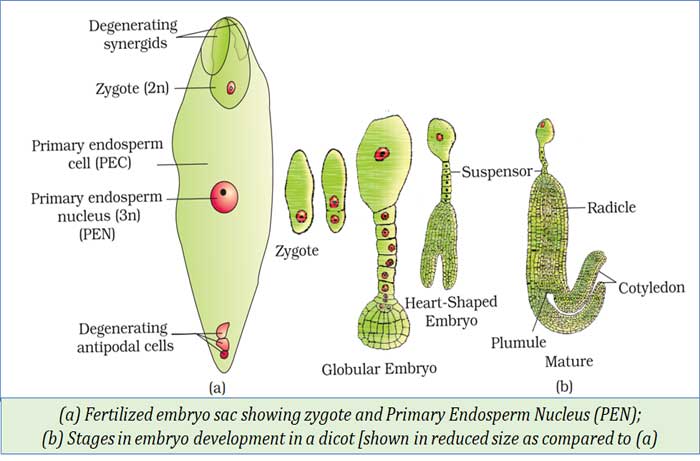
Structure of Embryo
Parts of a mature embryo:
(1). Embryonal axis
(i). Plumule
(II). Radicle
(2). Cotyledons
STRUCTURE OF DICOT EMBRYO
Embryonal Axis
Ø A mature dicot embryo consists of:
(1). Embryonal Axis
(2). Two Cotyledons
(1). Embryonal Axis
Ø Embryonal axis has two ends – Epicotyl and Hypocotyl
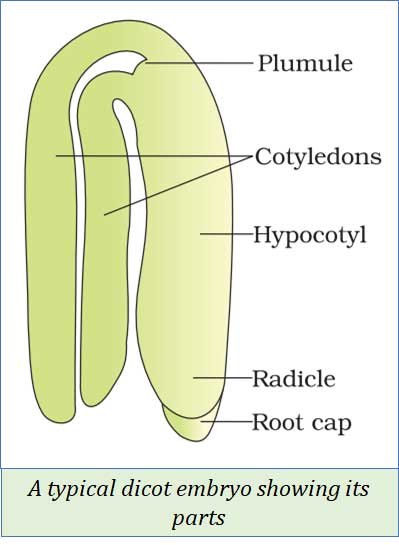
Epicotyle
Ø The part of embryonal axis above the level of cotyledons.
Ø Epicotyle ends in plumule or stem tip.
Ø Plumule develops into shoot system.
Hypocotyl
Ø The part of embryonal axis below the level of cotyledons
Ø Hypocotyl ends in radicle or root tip.
Ø Radicle develops into root system.
Ø Radicle is covered with root cap or calyptra.
Ø Root cap protects the root tip and help in downward growth of root through the soil.
(2). Cotyledons
Ø Cotyledons are the leaves at the embryonic stage
Ø A dicot embryo consists of two cotyledons.
STRUCTURE OF MONOCOT EMBRYO
Ø A mature monocot embryo consists of:
(1). Embryonal Axis
(2). One Cotyledon
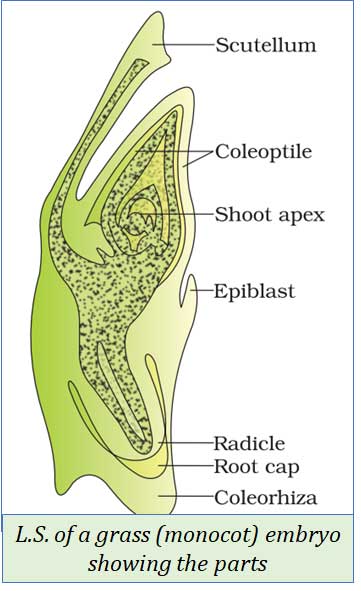
(1). Embryonal Axis
Ø The embryonal axis possesses radicle at the lower end.
Ø Radicle is covered by root cap.
Ø Radicle and root cap are enclosed in a sheath called coleorhiza.
Ø The portion of the embryonal axis above the level of attachment of scutellum (cotyledons) is the epicotyl.
Ø Epicotyl consists of shoot apex.
Ø Shoot apex is covered by protective sheath called coleoptile.
Ø Coleoptile encloses a few leaves primordia.
(2). Cotyledon
Ø Monocot embryo possess only one cotyledon
Ø Cotyledon in grasses is called scutellum
Ø It is placed laterally to the embryonal axis
SEED
Ø Fertilized mature ovule is called seed.
Ø It contains the embryo.
Ø Seeds are formed inside the fruit (fruit is mature ovary)
Structure of Dicot Seed
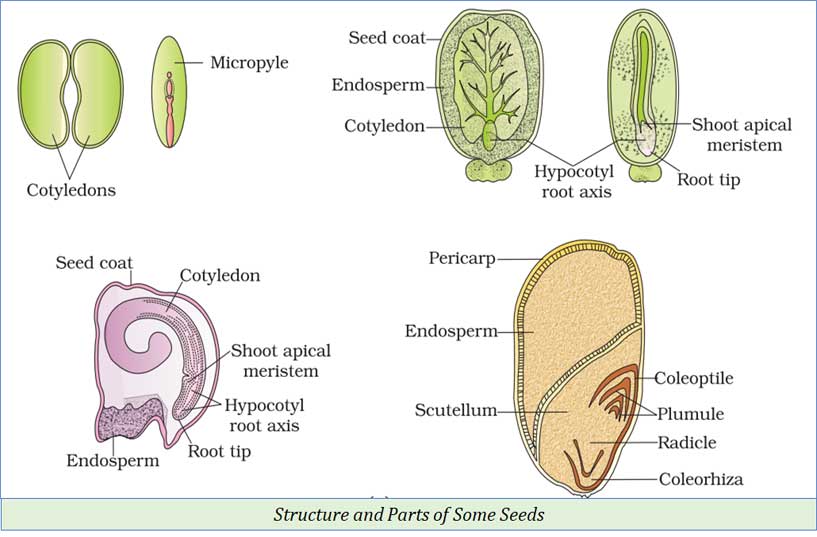
Ø Dicot seed consists of:
(1). Seed coat
Ø It is double layered
Ø Outer layer is testa and inner layer is tegmen
Ø It provides protection
(2). Micropyle
Ø Micropyle is a small pore in the seed coat.
Ø It is the retained micropyle of the ovule.
Ø It helps in the entry of water and oxygen during germination.
(3). Hilum
Ø A scar left by the funicle or the stalk of the ovule on the seed is called hilum
(4). Embryo
Ø It consists of two cotyledons and embryonal axis
(4). Endosperm
Ø The nourishment tissue of seed
Ø Majority of dicot seeds do not have endosperm.
Ø It may get consumed during the development of the embryo.
Structure of Monocot Seed
Ø Monocot seed – example – Maize seed
(1). Seed coat
Ø Testa is fused with pericarp (fruit wall)
Ø It provides protection
(2). Embryo
Ø It consists of a shield shaped cotyledon.
Ø The cotyledon is known as scutellum.
Ø The embryonal axis is seen in the cotyledon.
Ø The upper portion of the embryonal axis is the plumule.
Ø The lower portion is the radicle.
Ø The plumule is covered by a sheath called coleoptile and radicle is covered by coleorhiza.
(3). Endosperm
Ø Majority of monocot seeds possess endosperm
Ø It is rich in stored food materials
Ø It provides nourishment to the developing embryo
Ø In maize, endosperm is surrounded by a protein rich layer called aleurone layer
TYPES OF SEEDS
Based on the presence or absence of endosperm, seeds are of two types:
(1). Endospermous seeds or Albuminous seeds
Ø Seeds with endosperm are called endospermous or albuminous seeds
Ø Endosperm stores reserve food for the developing embryo
Ø Eg. Maize, wheat, barley, castor
(2). Non-endospermous seeds / Non-albuminous seeds
Ø Seeds without endosperm
Ø Endosperm is consumed by the developing embryo
Ø Eg. Ground nut, pea, beans, cashew nut, sunflower
PERISPERM
Ø The residual, persistent nucellus in the seed is called perisperm.
Ø Eexample: Black pepper, beet
Similar Terms
(1). Endosperm: The tissue present in seeds that provide nourishment to the developing embryo
(2). Perisperm: The residual, persistent nucellus
(3). Pericarp: Name of the fruit wall
Seed Dormancy
Ø Seed dormancy is the inability of a seed to germinate even in the presence favourable conditions.
Significance of Seeds
Ø Seeds contain embryo and help in propagation of plants
Ø Seeds are rich in reserve food for providing nourishment to the embryo
Ø The embryos are well protected inside the seed coat
Ø Seeds are produced by sexual reproduction, and thus create genetic recombination and variation
Ø Our agriculture is mainly based on seeds
Ø Seed dormancy and seed dehydration help in storage of seeds
Ø Seeds are rich in nutrients and are a part of our daily food
Seed Viability
Ø Seed viability is the ability of a seed to germinate under favourable condition.
Ø Viability period vary from seed to seed.
Ø Eg. Oxalis: a few months.
Ø Trifolium: hundreds of years
Ø The oldest viable seed: Lupines arcticus (Lupine), excavated from Arctic Tundra
Ø Date palm seed excavated from King Herod’s palace: 2000 years old
FRUITS
Ø The fruit is the ripened (mature) ovary.
Ø Fruit wall is called pericarp.
Ø Types of fruits based on the nature of fruit wall:-
(I). Fleshy fruits
Ø The fruit wall is soft and fleshy
Ø Eg. Mango, Orange, Guava
(II). Dry fruits
Ø The fruit wall is dry
Ø Eg. Mustard, Ground nut
Ø Types of fruits based on development:
(I). True Fruit
Ø Fruits which develop only from the ovary
Ø Eg. Wheat, Maize, Pea
(ii). False Fruit
Ø Fruits which develop from floral parts other than the ovary (thalamus or pedicel)
Ø Eg. Strawberry, cashew, apple
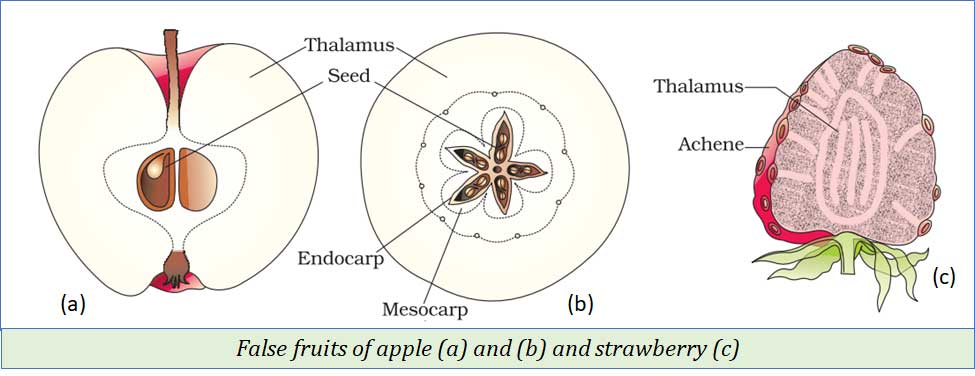
Parthenocarpic Fruits
Ø These are the fruits which are developed without fertilization.
Ø Ovary develops in to fruits without fertilization.
Ø Parthenocarpic fruits are seedless fruits
Ø Example: Banana
Ø Growth hormones can be applied to produce parthenocarpic fruits in agriculture.
APOMIXIS AND POLYEMBRYONY
(a). Apomixis
Ø Apomixis meaning: Away from mixing
Ø It is a method of reproduction in which seeds are formed without fertilization (fusion of gametes).
Ø In this method, seeds are formed asexually from the maternal tissues (diploid) of the ovule without involving meiosis and fertilization.
Ø The embryo thus formed is identical to the parent
Types of Apomixis:
(i). Parthenogenesis: The development of female gamete (egg) into a new organism without fertilization. Here, the egg cell is diploid which is formed without meiosis
(ii). Parthenocarpy: The development of ovary into fruit without fertilization
Importance of Apomixis in Agriculture
Ø Apomixis does not involve mixing or sexual fusion of gametes
Ø So, there is no segregation of genes
Ø Genetic make-up remains the same
Ø This property can be utilized in the production of apomict seeds of hybrid plants
Ø If the hybrids are made into apomicts, such seeds can maintain same genetic make up
Ø So, there is no need to buy hybrid seeds every season
(b). Polyembryony
Ø Formation of many (or more than one) embryos within the seed.
Ø Example: Onion, mango, ground nut, orange, conifers, citrus etc.
Ø Reasons for polyembryony
(1). Presence of more than one egg in the embryo sac and they all may get fertilized.
(2). Presence of more embryo sacs in the ovule.
(3). Presence of more embryos – that develop from different parts of the ovule such as synergids, antipodals, nucellus tissues, integuments, egg cell (fertilized / unfertilized) etc.
With this, we have completed the discussion of chapter-2 of Plus Two Botany (Sexual Reproduction in Flowering Plants).You can Download the PDF of this note from the link given below. Hope this post was helpful for your learning. We would like to hear it from you. Please COMMENT (below ↓)
<<< Back to PLUS TWO BOTANY NOTES Page
You might also like…
@. Plus Two Biology Previous Year Question Papers
@. Plus One Biology Previous Year Question Papers
@. Model Question Papers
